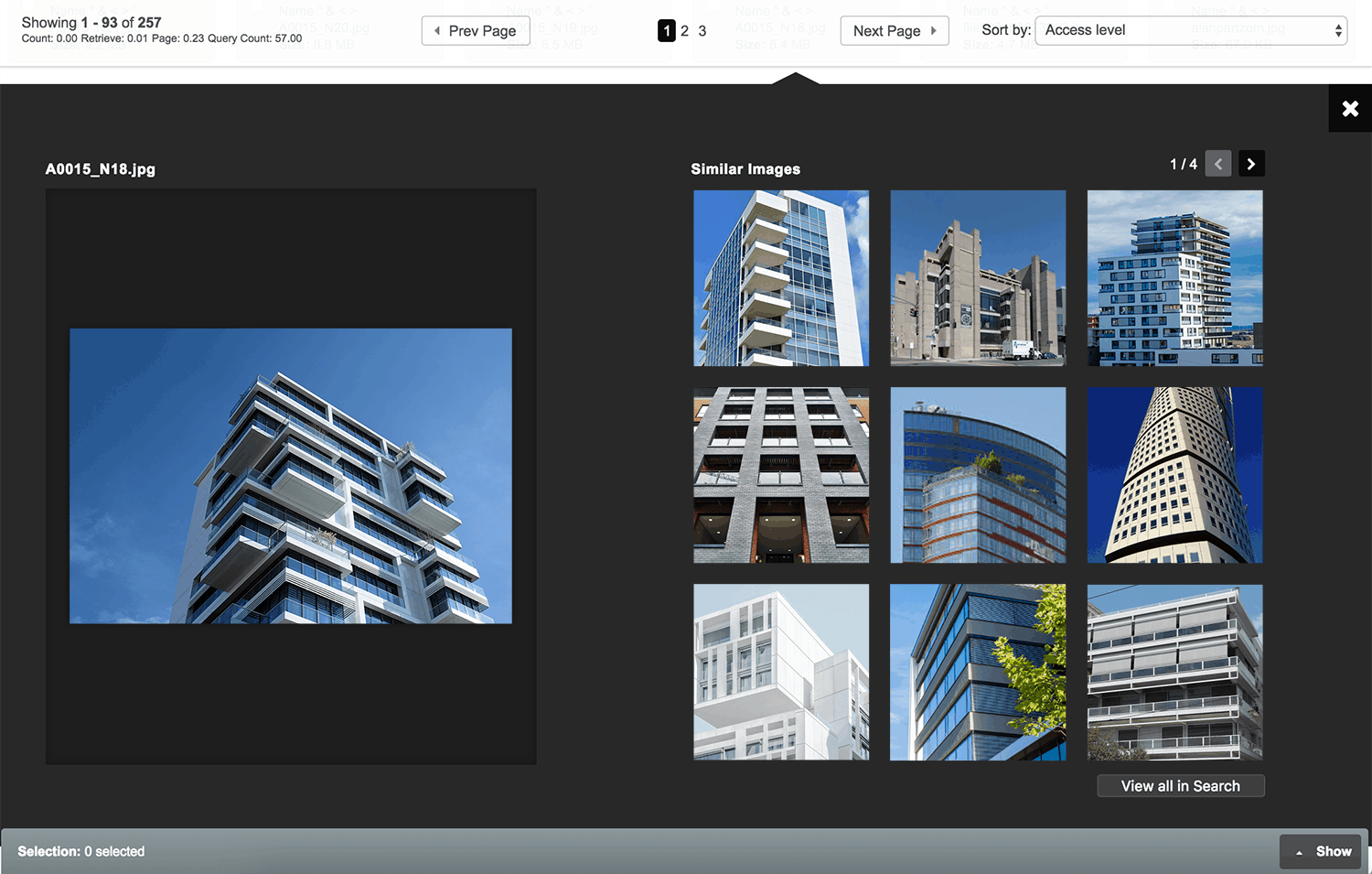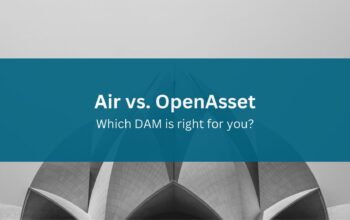A big challenge for Digital Asset Management (DAM) is applying useful metadata for images at scale. DAM users typically apply tags to files and projects using a keyword structure; a well-organized DAM allows users to search and compare images with ease using keywords. However, this is a manual process and requires an investment of time and money, which can be challenging to scale up as the business grows.
We believe that the integration of Artificial Intelligence (AI) into Digital Asset Management will improve user experience and the quality of search. The introduction of machine learning into asset tagging will make the process of labeling images significantly more efficient for users.
As the leading Digital Asset Management provider for companies operating in the Architecture, Engineering, and Construction (AEC), and Real Estate industries, OpenAsset is continually offering improvements to our SaaS products that help to deliver this vision.
To evolve OpenAsset into a machine-learning DAM system and introduce AI-powered features, our software engineers have carried out extensive research and development. We have tested a variety of approaches to establish the most valuable applications of AI for the AEC and Real Estate industries.
What are the benefits of AI for asset management?
There is increasing interest in Artificial Intelligence, and the concept has taken on a broad range of definitions. As an emerging technology, the applications of AI continue to be debated, with companies often unable to substantiate the grand claims made for its potential.
AI cannot run a marketing department or design the blueprint for a skyscraper. However, you can achieve realistic goals for AI tech by being clear about the strategic objectives that you wish to serve. In so doing, AI’s specific capabilities can be adapted to suit your particular industry, and the significant technical challenges presented by AI adoption can be easier to navigate.
AI is a subset of machine learning that deploys algorithms to large sets of data, enabling computers to mimic human intelligence. AI is central to the predictive modeling used by e-commerce companies such as ASOS, or video streaming companies like Netflix. Anyone who has received targeted web ads will have encountered AI technology.
Although AI is embedded in the web-enabled services we use daily, the technology underpinning AI is rapidly accelerating. Economic forecasters have identified it as a critical area of growth that businesses will need to consider to remain competitive.
Cloud Computing
One of the main drivers for the rise of AI is the shift from local network storage to cloud computing. Increased use of cloud-based networks by businesses has made available the large data sets necessary for machine learning.
Cloud servers can store nearly unlimited volumes of data. They can also deliver analytics in real time, offering analysts the capability to provide improved insights. By creating data models that mirror the neural networks of the human brain, software engineers have been able to develop sophisticated algorithms that power AI.
The AI services available for integration into SaaS products via API has also stimulated widespread adoption. The launch of services by companies such as Google, Amazon, Microsoft, and IBM has enabled businesses to benefit from the research and development efforts of these companies, without the prohibitive costs.
This approach has built a developmental ecosystem whereby large companies undertake the innovation work that improves the efficiency and power of AI tech. Smaller companies then use disruptive innovation to open the technology up to new markets and users.
Natural Language Processing
The other significant advancement aiding the adoption of AI technology is Natural Language Processing (NLP). NLP is a domain of computer science and is concerned with how to program computers to process and analyze large volumes of human (natural) language.
This research is generally believed to have started in the 1950s with the eponymous tests of Alan Turing. However, AI technology has helped facilitate a recent breakthrough that has enhanced the ability of computers to grasp the nuances of natural language. These are the nuances necessary for everyday interactions.
Services such as Google Translate previously relied on a technique known as ‘statistical language inference’, whereby vast volumes of existing translations were cross-referenced to predict the meaning of individual words. With the introduction of neural networks, these programs began to understand how languages function by developing a model that mapped all the relations between the words in a language.
AI services can understand and convey emotional intelligence that is of most value to companies deploying Martech services. Using AI-powered software, companies can better understand the needs of their customers. Automated communications such as email programs and chatbots can be tailored to suit individuals, rather than groups.
How can Digital Asset Management help?
Digital assets are electronic files that provide value to an organization. They may include photos, videos, PDFs and any other file that can be used to visualize your products and services.
Storing digital assets on shared drives or network servers can create problems, especially as a company grows, if they undergo a period of change (such as a merger or acquisition), or undertake a Digital Transformation project. Furthermore, changes to file naming conventions, data migrations, and complex folder structures can result in digital assets being lost.
This is where a Digital Asset Management platform like OpenAsset can help. By collating digital content into one location, tagging files with keywords, and making it searchable, anyone in an organization can access and compare assets with ease.
This is of particular value to AEC and Real Estate companies, not only because of the large volume of visual assets they store but also due to the project-oriented nature of their work. As well as simplifying the process of searching for assets, OpenAsset offers integrations with the systems marketers use every day, including Deltek Vision, PowerPoint, InDesign, and KA Synthesis.
DAM with AEC and Real Estate
How AEC and Real Estate firms benefit from a DAM might vary across industries. For Architecture firms, the ability to visually communicate design concepts is crucial to winning new business. Firms hire professional photographers to take high-quality images for promotional materials; making sure photos assets are searchable and available on demand is essential to retaining their value.
Engineering and Construction firms generate a significant volume of commercial material for bids. Due to high costs and slim margins related to some projects, the bidding process can be fiercely competitive. The ability to draw on high-quality project images at speed can help distinguish a company from the competition and demonstrate their expertise.
The commercial and residential Real Estate industry is fast-paced, with large teams collaborating on the production of marketing collateral. With a DAM, admins can set user permissions for images, ensuring that only approved imagery is available. Having control over assets reduces the risk of costly legal disputes that can arise from misused assets.
Below are some of the key benefits that a DAM platform can bring to AEC and Real Estate firms:
- Batch uploading of metadata allows keywords to be assigned to groups of images. This speeds up data processing and quickly enables you to make images searchable
- Simplified file sharing reduces the amount of network storage used by file downloads
- The ability to view projects in Google Maps helps to contextualize them
- Integrations with key software packages like InDesign and PowerPoint allow for the creation of bespoke templates that can be configured easily by administrators
- Presentation documents and bid proposals can be produced seamlessly, with the assurance that images are consistent with style guidelines and appropriate for the brief
- The project-focused structure of DAM platforms like OpenAsset is set up for the needs of AEC and Real Estate industries
- Employee objects can speed up the production of resumes
- Editing features such as image size presets decreases the time spent editing images for use
AI & Machine Learning in OpenAsset
Until now, users searching for images within OpenAsset relied upon keywords that had been selected by other users. Manually applying metadata in a large database of images is a time-consuming process, requiring staff or image librarians who are trained to use a specific keyword structure. Machine learning and AI changes all of that.

Machine Learning and Digital Assets.
Until metadata has been applied to assets, they are not in a searchable state and are unable to deliver value. Machine learning can be utilized for asset tagging, which delivers a number of benefits for DAM admins and users. Features such as the Image Similarity search feature in OpenAsset saves time and offers enhanced user experience with no extra administrative effort.
Image Similarity
The development of the Image Similarity search feature is our first venture into incorporating OpenAsset with AI technology. The feature uses data from the image recognition service Amazon Rekognition in order to calculate the probability of images featuring similar content. This offers users a new way of discovering images that work alongside metadata-based searches. Users may already be familiar with image similarity, or ‘reverse image search’ features in Google, Bing, Instagram or Pinterest.
When a customer selects an image in OpenAsset, the Image Similarity feature will return a selection of images from across the entire image library that it identifies as being visually similar. We believe that this feature should be easy and intuitive to use, offering value in a number of ways:
Users can discover images of buildings that share common architectural styles, similar patterns or compositions, or which feature specific building elements, such as an atrium or a spiral staircase
Searches can commence without the user having to decide upon specific search terms, increasing the opportunity for unexpected and creative image combinations
If valuable search terms are missing from the keyword structure, Image Similarity search could speed up the process of identifying images missing these terms
Keyword Suggestions
In the near future, we are aiming to introduce the ability for OpenAsset to offer AI-assisted keyword suggestions. Using image recognition it may be possible for OpenAsset to select relevant tags from your organization’s keyword structure, thus minimizing the effort of image tagging, while maximizing the effectiveness of search.
The main technical challenge in developing this feature is to be able to convert the image recognition data into valuable search terms that are relevant to the images used by our clients in the AEC and Real Estate industries. The models on which image recognition services are built are trained to recognize images to suit the broadest possible range of use cases. Their level of accuracy when analyzing images of the built environment can vary and they often lack the specific contextual information that is of value to our clients. In order to understand the types of keyword suggestions that would be useful to customers, we closely examined the way in which our users classify their digital assets.
By analyzing the data within OpenAsset, we discovered that users have amassed a total of around 15,000 project and file keywords. Leveraging our expertise of how customers within the AEC and Real Estate industries use keywords to tag their assets, we were able to develop a broader picture of how this data could be used to improve search functionality. With more focussed analysis, we established patterns in how users applied certain keywords, arriving at a smaller set of a few hundred search terms that frequently recur across OpenAsset.
Developing a set of useful keywords was the starting point of our AEC and Real Estate keyword ontology. The keywords function like a vocabulary that can be used to describe images. In order for our software to predict the contents of new unseen images, it requires a set of rules that govern how the keywords relate to these images. This is known as a classifier, which is an advanced system of algorithms that can translate the generic output of an image recognition program into meaningful keyword suggestions. Using our analysis of how users select keywords, we are aiming to develop a classifier that can respond to the particular requirements of images of the built environment.
OpenAsset users will soon receive inline suggestions for project level keywords and further down the line, file level keywords as well. As AI technology advances, it may become possible to fully automate the process of tagging assets. By gradually incorporating greater levels of AI- and IR-powered technology, we are ensuring that our product is delivering tangible benefits to users while setting ourselves up to take advantage of future developments.



